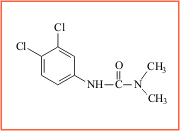Photosynthetic Herbicides
Over 60% of the herbicides introduced in the last 40 years act on the chloroplast functions (Wakabayashi and Böger, 2002). More than half of all commercially available herbicides in the 70-es are inhibitors of photosynthesis and, more specifically, of the Photosystem 2 electron transport (Oettmeier, 1992).
Classification
The Herbicide Resistance Action Committee classifies the inhibitors of PS2 as group C, which is further divided intro three subgroups according to the chemical structure:
- C1 — triazines (atrazine, propazine, simazine), triazinones (metribuzin), uracils (bromacil), triazolinones, pyridazinones, and phenyl-carbamates;
- C2 — ureas (diuron, isoproturon, linuron, chlorotoluron) and amides (propanil);
- C3 — nitriles (bromoxynil, ioxynil), benzothiadiazinones, and phenyl-pyridazines.
There are some herbicides, such as dinoseb, classified in other groups but also having an inhibitory effect on PS2.
In many photosynthetic studies the herbicides are grouped into two families — the urea/triazine family and the phenol family. There are a number of characteristic differences in the action of these two families. For example, Tris treatment of the thylakoid membranes strongly reduces the binding of urea/triazine herbicides but the binding of phenolic herbicides is not affected (Trebst et al., 1985). There is a defined lag (1-2 min) in the inhibition of the electron transport after treatment with phenolic herbicides (Durner et al., 1986). Also, mutants in which the Ser264 residue of the D1 protein of PS2 is subsituted are resistant to urea/triazines but sensitive to phenols (Bowyer et al., 1991).
Mode of action
It was discovered already in the 50-es that diuron inhibits the photo-induced electron transport through PS2. Duysens and Sweers (1963) postulated that diuron blocks the reoxidation of QA−, which was affirmed in many other studies. Now it is commonly accepted that the photosynthetic herbicides bind to the QB-site of PS2 (on the D1 protein) competitively displacing the plastoquinone from it and thus block the transfer between QA and QB. The exact binding locations of the herbicides and PQ are not identical but close to one another and overlapping (Pfister and Arntzen, 1979).
It is worth noting that the urea/triazine herbicides bind to the D1 protein via hydrogen bonds with Ser264 and the phenolic herbicides form bonds with His215. That is why these two groups of herbicides are also called Ser264 and His215 family. Diuron (urea) and atrazine (triazine) are of the Ser264 family and dinoseb (phenol) belongs to the His215 family.
